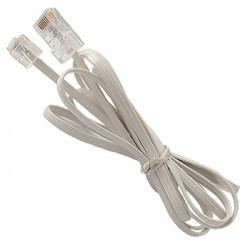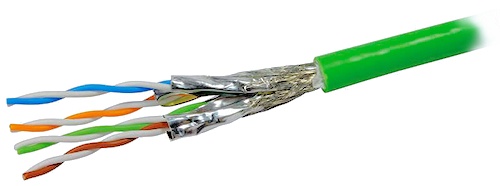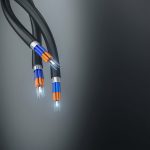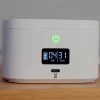The Importance of Connecting ADSL and FTTC Broadband via Twisted Pair Cable

It’s often painfully easy to find yourself buying or receiving the wrong sort of RJ11 telephone cable to connect between a BT faceplate / master socket and your ISPs broadband ADSL / VDSL (FTTC) modem or router. Sadly this can have an impact on your lines performance so it’s important to understand why and if you should care.
Some people might be surprised to learn that ISPs sometimes ship non-twisted (straight) DSL cable with their pre-packaged broadband routers. BT’s HomeHub 5 kit (here), which ships alongside the operators top-end superfast up to 38Mbps or 76Mbps “fibre broadband” (BTInfinity) FTTC package, is a prime example.
Advertisement
A BT Spokesperson told ISPreview.co.uk:
“The BT Home Hub 5 Router comes with a cable which has been tested as being suitable for application. This cable passes the TR100 tests.”
Indeed it’s true, the cable BT bundles with its HH5 kit has been tested and does pass the TR100 tests but that doesn’t mean to say you aren’t losing performance because of it. Similarly Sky Broadband has also told us that they “use non-twisted cables“. Meanwhile other ISPs, such as TalkTalk, claim to include twisted pair cables with their kit. Some do, some don’t.
But does it really make any difference (twisted vs non-twisted)? Some ISPs have been doing this for years and very few consumers ever seem to notice any directly related problems, although there are usually bigger issues to worry about than the local cable and if the connection itself appears to work then consumers might not always be aware of what they’re missing.
Explaining the Twist
The first thing to understand is that Radio / Electromagnetic Interference (EMI) is everywhere, it leaks to varying different degrees and over various different spectrum frequencies from your power adapters, TV, microwave ovens, DECT phones, home computer, radio, Christmas tree lights, passing high speed trains, space.. and the list goes on.
Sadly some of this EMI, which is mostly at a level that is harmless to humans, can find its way into your telephone cables and cause a performance loss or sometimes even connection problems. But today we’re taking a look at interference in the home and not the national telecoms infrastructure as a whole.
Advertisement
Thankfully most reputable companies ensure that their devices are properly manufactured to include good shielding and components, which reduces the local levels of EMI. But tackling interference is a constant battle and over the years various methods have been invented to mitigate the problem, which leads to a cleaner transmission and thus better performance.

One of the simplest and most elegant inventions came from Alexander Graham Bell in 1881. Bell realised that twisting cables around each other could reduce interference on the line (i.e. crosstalk, RFI and EMI) and thus clean up his signal, which works because the direction of the noise ‘current’ is the opposite from the ‘current’ in other parts of the cable and this acts to reduce the interference. It also helps to stop the cables from separating, which can create additional problems.

Admittedly we’ve over-simplified things but the rule is clear enough, twisted + shielded cable (i.e. shielding conductor sheath / electrostatic shield) = good.
The Difference
In a straight cable, which is cheaper to make, the noise current just flows in the same direction and this makes it much more of a problem, especially if you happen to be running your connection over several metres of extension cable. In this situation the likelihood that EMI will leak into your line and hamper the connection increases as the length of line grows.
Advertisement
The solution is to A) keep the cable between your socket and router/modem very short (i.e. less than 1 metre is always a good idea.. we use about 0.25m on ours) and B) spend a small amount on a proper shielded twisted-pair RJ11 lead (example 1 and example 2) that will usually set you back no more than £5 or so (it’s better to ask for these in shops like Maplin as online the delivery often costs more than the cable).
On top of that it’s also wise to keep your router and cable as far away from other electronic devices as possible, just to limit the potential harm from any EMI that might find its way into your cable.
But does any of this actually help? The answer is yes, although whether or not you’ll notice the difference is another matter and experiences will vary (you’re more likely to see a benefit if you currently use several metres of non-twisted extension cable). For example, on some FTTC and ADSL2+ lines you might potentially notice a tiny speed boost that could at most be equivalent to perhaps +1-2% performance (guesstimate based on some limited examples).
However such a low figure is arguable well within the margin of error (i.e. most broadband lines naturally fluctuate by that much or more) and thus you might be forgiven for not noticing any difference, unless you monitor intensely over a longer period of time (both before and after the cable change). On the other hand you might notice a slight improvement in your connection stats and fewer line errors, which while not huge are still a benefit.
At the end of the day this is really all about being prudent and giving your broadband connection the best possible chance to deliver a good and stable service. After all, it’s cheap to buy a proper cable, so why skimp?
Mark is a professional technology writer, IT consultant and computer engineer from Dorset (England), he also founded ISPreview in 1999 and enjoys analysing the latest telecoms and broadband developments. Find me on X (Twitter), Mastodon, Facebook, BlueSky, Threads.net and Linkedin.
« FRITZ!Box 7490 Broadband VDSL and ADSL Router Adds Gigabit WiFi






















































Comments are closed